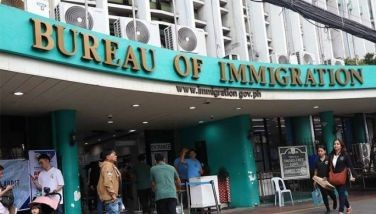It’s Bt corn harvest time
June 1, 2003 | 12:00am
LOS BAÑOS, Laguna – It’s Bt corn harvest season in the countryside.
The first commercial genetically modified (GM) corn have been harvested in Isabela.
And the results were remarkable, as reflected by figures furnished The STAR by the Los Baños-based SEARCA Biotechnology Information Center (BIC).
For instance, Jose Denna, a farmer from Ilagan, harvested 9.5 tons per hectare from the Yieldgard corn (DK 818YG)-Bt corn MON810 of Monsanto, which is significantly higher than his usual yield of only six tons/ha.
The average yield for yellow corn in the country is 2.4 tons/ha.
Data on the initial yield of the first commercially produced Bt corn are still being analyzed.
The commercial release for propagation of Monsanto’s Bt corn-MON810 was approved last December by the Department of Agriculture after intensive scientific studies and farm trials since 1996.
The first wave of Bt corn were planted in at least 127 hectares in 10 provinces.
Aside from those in Isabela, programmed to be harvested during the April-May period were those planted last December-January in Pangasinan, Cagayan, Quirino, and Ifugao, according to Dr. Arnold Estrada, product development manager of Monsanto Philippines, Inc.
Those planted last February in Ilocos Norte are projected to be harvested from May 29 onwards.
Farmers in Koronadal (South Cotabato), Carmen (North Cotabato), and Quirino (Sultan Kudarat), all in Mindanao, planted last March and expect to harvest their Bt corn during the June-July period.
Earlier during the Feb. 25-March 1 period, a group composed of 36 farmers, government personnel workers, and members of the media from Thailand and the Philippines visited Bt corn farms in Isabela to gain first-hand information on the performance of these GM crops in farmers’ fields.
"The farmers observed the vigorous growth of Bt corn undamaged by corn borers as compared to the conventional hybrids growing in other farms," reported Sonny P. Tababa, SEARCA BIC network administrator.
Also, Tababa noted that the visitors made conscious effort to go inside the fields instead of just observing the border plants.
The visit likewise afforded the sharing of experiences in corn production and management between the Thai and Filipino farmers in the group.
One of the Filipino farmers, Hector Madriaga, planned to expand his area for Bt corn upon seeing the good performance of the transgenic corn planted in Isabela.
Another farmer-leader, Isidro Acosta Jr., expressed his support for new technologies and that Bt corn, as per the results in Isabela, can improve yield, thus, will help the livelihood of farmers.
Edwin Paraluman, head of the Nursery Farmers’ Irrigators Association (NUFLA) in General Santos City, South Cotabato, shared his experiences regarding the anti-GMO issue in his area.
Paraluman asserted that farmers have the right to choose the technology to be used on their farms and they should be given the chance to plant Bt corn.
Undersecretary Tetchi Capellan of the Office of the President-Million Jobs Program stressed the government’s support for the safe and responsible use of biotechnology.
She stressed the following:
• Bt corn production is important to improve yields and to secure food supply via the poultry and livestock sector as major users of yellow corn.
• Farmers should be encouraged to speak out louder and be heard so that policymakers will listen to what they want.
• Advocacy by farmers will help the scientists as the latter will provide the scientific backstopping.
• If farmers will adopt Bt corn there will be a common regional experience on this technology and that this will provide opportunities for regional cooperation.
The first commercial genetically modified (GM) corn have been harvested in Isabela.
And the results were remarkable, as reflected by figures furnished The STAR by the Los Baños-based SEARCA Biotechnology Information Center (BIC).
For instance, Jose Denna, a farmer from Ilagan, harvested 9.5 tons per hectare from the Yieldgard corn (DK 818YG)-Bt corn MON810 of Monsanto, which is significantly higher than his usual yield of only six tons/ha.
The average yield for yellow corn in the country is 2.4 tons/ha.
Data on the initial yield of the first commercially produced Bt corn are still being analyzed.
The commercial release for propagation of Monsanto’s Bt corn-MON810 was approved last December by the Department of Agriculture after intensive scientific studies and farm trials since 1996.
The first wave of Bt corn were planted in at least 127 hectares in 10 provinces.
Aside from those in Isabela, programmed to be harvested during the April-May period were those planted last December-January in Pangasinan, Cagayan, Quirino, and Ifugao, according to Dr. Arnold Estrada, product development manager of Monsanto Philippines, Inc.
Those planted last February in Ilocos Norte are projected to be harvested from May 29 onwards.
Farmers in Koronadal (South Cotabato), Carmen (North Cotabato), and Quirino (Sultan Kudarat), all in Mindanao, planted last March and expect to harvest their Bt corn during the June-July period.
Earlier during the Feb. 25-March 1 period, a group composed of 36 farmers, government personnel workers, and members of the media from Thailand and the Philippines visited Bt corn farms in Isabela to gain first-hand information on the performance of these GM crops in farmers’ fields.
"The farmers observed the vigorous growth of Bt corn undamaged by corn borers as compared to the conventional hybrids growing in other farms," reported Sonny P. Tababa, SEARCA BIC network administrator.
Also, Tababa noted that the visitors made conscious effort to go inside the fields instead of just observing the border plants.
The visit likewise afforded the sharing of experiences in corn production and management between the Thai and Filipino farmers in the group.
One of the Filipino farmers, Hector Madriaga, planned to expand his area for Bt corn upon seeing the good performance of the transgenic corn planted in Isabela.
Another farmer-leader, Isidro Acosta Jr., expressed his support for new technologies and that Bt corn, as per the results in Isabela, can improve yield, thus, will help the livelihood of farmers.
Edwin Paraluman, head of the Nursery Farmers’ Irrigators Association (NUFLA) in General Santos City, South Cotabato, shared his experiences regarding the anti-GMO issue in his area.
Paraluman asserted that farmers have the right to choose the technology to be used on their farms and they should be given the chance to plant Bt corn.
Undersecretary Tetchi Capellan of the Office of the President-Million Jobs Program stressed the government’s support for the safe and responsible use of biotechnology.
She stressed the following:
• Bt corn production is important to improve yields and to secure food supply via the poultry and livestock sector as major users of yellow corn.
• Farmers should be encouraged to speak out louder and be heard so that policymakers will listen to what they want.
• Advocacy by farmers will help the scientists as the latter will provide the scientific backstopping.
• If farmers will adopt Bt corn there will be a common regional experience on this technology and that this will provide opportunities for regional cooperation.
BrandSpace Articles
<
>
- Latest
Latest
Latest
May 14, 2024 - 3:43pm
By Ian Laqui | May 14, 2024 - 3:43pm
April 10, 2024 - 5:12pm
By Ian Laqui | April 10, 2024 - 5:12pm
March 4, 2024 - 3:32pm
By Ian Laqui | March 4, 2024 - 3:32pm
March 4, 2024 - 2:12pm
By Kristine Daguno-Bersamina | March 4, 2024 - 2:12pm
February 17, 2024 - 2:31pm
February 17, 2024 - 2:31pm
Recommended



























